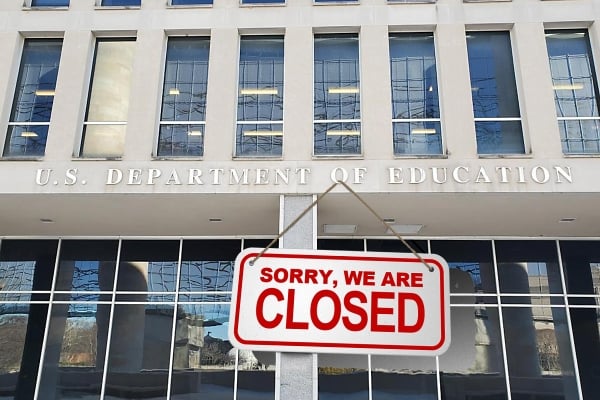
What to Know About the Government Shutdown and Higher Ed
About 95 percent of the Education Department’s employees who don’t work on federal student aid will be furloughed for the first week of the shutdown.
Photo illustration by Justin Morrison/Inside Higher Ed | Getty Images
For the first time since 2019, the government is shutting down after Congress failed to reach an agreement to fund federal agencies.
About 95 percent of employees at the Education Department who don’t work on federal student aid will be furloughed without pay in the first week, along with thousands of others throughout the federal government. Other workers deemed essential to keep key operations running will have to work without pay. If the shutdown lasts more than a week, the Education Department expects to bring up to 330 employees back, which would keep about 87 percent of the workforce furloughed, according to the agency’s draft plans.
Student aid dollars will continue to flow through programs including the Pell Grant, student loan payments will be due and the Free Application for Federal Student Aid will remain open. However, the department is planning to cease grant-making activities and pause civil rights investigations. Officials will also move forward with meetings to review proposed regulatory changes—a key step in a lengthy process known as negotiated rule making. Pushing off this week’s meetings likely would’ve made it difficult for the department to adhere to an already tight timeline to finalize new rules by next July.
Elsewhere, the shutdown will curtail federal services, and the Labor Department won’t release new jobs data. And Trump officials are suggesting they could lay off employees and cut off other services. But for higher ed, the shutdown likely won’t cause significant disruptions at first.
Here are three things to know about the shutdown and how it could affect America’s colleges and universities.
Direct Impact Limited, for Now
The general rule of thumb for a shutdown is that the longer it lasts, the more disruptive it will be. The American Council on Education’s fact sheet about shutdowns said brief ones “have limited direct effects” on institutions. But this shutdown, coming eight months into the Trump administration, will likely add even more uncertainty to operations for colleges, faculty and students.
“When colleges and universities budget for the fiscal year, they don’t budget for a shutdown,” said Emmanual Guillory, senior director of government relations at ACE. “Potential loss of revenue is always a concern with the bottom line.”
He added that because of the furloughs, communications with the agency will likely be disrupted. For instance, if an institution has a question about an ongoing civil rights investigation, they’ll likely have to just wait for an answer. He advised institutional leaders to “be mindful of the length” of the shutdown and “what that can mean for revenue and compliance.” When operations do resume, agency staff will likely return to a backlog of work.
The previous shutdown, which began in December 2018, lasted 34 days and delayed $18 billion in federal discretionary spending, according to ACE.
Experts are predicting that this shutdown could persist for several weeks, at least.
Disruptions to Research, Visas
The National Institutes of Health will furlough about 75 percent of its staff and stop all grant reviews as well as travel and basic research. Similarly, the National Science Foundation won’t be awarding new grants, Science reported. But both agencies will still accept applications.
The last shutdown hindered research and caused other headaches for researchers who rely on the federal government for support. Some federal websites are expected to go off-line, and ACE’s fact sheet noted that in previous shutdowns, the Integrated Postsecondary Education Data System was inaccessible.
International students might also see some disruptions if they are waiting to get a visa appointment, but the embassies and consulates will remain open, according to ACE.
Threats of Deeper Pain
Adding to the uncertainty about the shutdown, President Trump and others are signaling that they plan to make it painful for Democrats, whom they blame for the impasse. For example, Russ Vought, the director of the Office of Management and Budget, threatened last week to lay off more federal employees unless Democrats agreed to pass the Republican-sponsored continuing resolution, which would’ve kept the lights on through Nov. 21. (Vought and the OMB had significant discretion in determining which government functions should continue during a shutdown.)
Trump echoed the layoff threat Tuesday.
“We can do things during the shutdown that are irreversible, that are bad for them and irreversible by them, like cutting vast numbers of people out, cutting things that they like, cutting programs that they like,” he told reporters.
The Trump administration has already fired thousands of federal employees, including nearly half of the workers at the Education Department. Unions, Democratic-led states and others sued to block the layoffs, but so far, the Supreme Court has allowed the administration to proceed. The unrestricted sacking of federal workers led Democrats in Congress to argue that there’s little stopping Trump officials from firing employees when the government is open, so a shutdown wouldn’t change things, Politico reported.
“Whether there’s a shutdown or not, they just keep firing government employees,” said Rep. Glenn Ivey, a Maryland Democrat. “I don’t know that capitulating on this front slows that down. In fact, it might actually encourage them to think that they can stay on the track that they’re currently on.”
Republicans in the Senate hold a 53-seat majority, but they need Democrats’ support to reach the required 60 votes to pass their continuing resolution to fund the government through Nov. 21.
Democrats want to cut a deal that would in part extend tax credits for Affordable Care Act plans and reverse Medicaid cuts included in the One Big Beautiful Bill Act. They argue that they’re open to negotiating, while Republicans say they are holding the government hostage.
The House is not in session this week.
Source link


